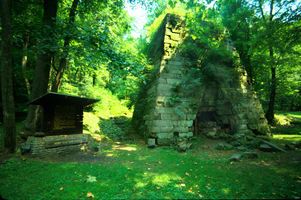
The Henry Clay Furnace, the first steampowered blast furnace in Western Virginia, was built on Clay Run in present Coopers Rock State Forest about 1836. Leonard Lamb erected the cut-stone furnace for Tassey, Morrison, and Company to supply pig iron to the nearby Jackson ironworks, an important regional ironworks.
After its completion, the furnace changed hands in rapid succession. The Ellicott brothers, Maryland ironmasters, purchased the Jackson ironworks and the Henry Clay Furnace property in 1839. The Ellicotts made extensive improvements to the ironworks, building a tram road that connected the furnace with the ironworks, which was located at Ices Ferry on the Cheat River. The brothers operated the furnace until about 1848, at which time the Ellicotts’ business failed.
The furnace converted or smelted the iron ore to pig iron. The ore was mined along the hillsides surrounding the furnace. In operation, the furnace was ‘‘charged’’ or filled with alternating layers of charcoal, iron ore, and limestone until entirely full. At this point it was fired and brought up to temperature slowly. After about eight hours the furnace was ready to be tapped. First the slag, which was lighter and floated on top of the molten iron, was released, then the molten iron was cast. The molten iron was run into a series of voids made in a bed of sand in front of the furnace. The voids, where the actual ingots were cast, were all connected by channels, through which the molten iron flowed from the furnace. The resulting pattern of iron ingots in the sand resembled piglets suckling at a mother sow, hence the name.
Once in operation the furnace was operated week in and week out, generally from the spring thaw to the winter freeze. The pig iron was sent to Jackson ironworks for conversion into wrought iron for use to make cut nails, while some iron was used to make cast-iron stoves.
Because of the remote and rural nature of iron making, a small self-sufficient community of 50 to 75 workers arose around the furnace. Life was not easy, and most workers lived in rough log buildings. Still there was a school and church at the furnace and a few more substantial structures related to the furnace’s operation. None of these structures remains. Henry Clay Furnace, however, still stands and is a popular hiking and biking forest destination. It was added to the National Register of Historic Places in 1970.
Read the National Register nomination.
This Article was written by Lee R. Maddex
Last Revised on August 03, 2023
Related Articles
Cite This Article
Maddex, Lee R. "Henry Clay Furnace." e-WV: The West Virginia Encyclopedia. 03 August 2023. Web. 26 July 2024.


Comments?
There aren't any comments for this article yet.
Click here to read and contribute to the discussion →